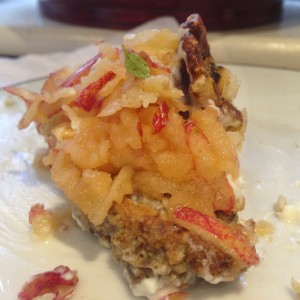
Cook and Travel: Sea Vegetables & Welsh Laverbread
It may seem odd to the British Readers, that I first heard about Laverbread only in February this year.
We had travelled to this charming, unpretentious gastropub near Abergavenny for a weekend in Wales – it’s where my son wanted to spend his 10th birthday. May have had something to do with the Dr. Who Experience in Cardiff.
The Clytha Arms was our sleepover destination – close enough to Cardiff for our Sunday afternoon Dr Who booking, but nonetheless deep in the heart of the Welsh countryside, a mere leap from the river Wye, surrounded by fields of fattening Welsh Spring lambs and mane-tossing mares; and in the pub, plenty of quilted jackets, muddy boots and a busy dart board.
The locals who filled the cosy pub took great pleasure in including our children in their dart games, teaching them how to get the darts closer to the board and further from the furry sheepdogs curled up trying to sleep at its base. I watched with a bemused smile from a fire-side position, book in lap, wine in hand. The quintessential British Pub experience. I thought I couldn’t be happier. Until we sat down for dinner.
The pub was unpretentious – charming but in a relaxed, naturally rustic way (not gentrified, just authentic, working rural charm.) I didn’t anticipate the refined food that was to come my way in the restaurant. For someone who had chosen the restaurant without thinking to take allergies into account, I was pleasantly astounded to find the menu so allergy friendly.
 The freshest seafood, wild game, local Welsh lamb (which apparently is very hard for the Welsh to source, as so much of it gets shipped away at exorbitant prices to London and Japan) – specialities like Potted Crab; Spatchcock; Wye Valley Asparagus; cockles; wild garlic faggots. Traditional food, prepared bravely and with utmost attention to detail. No shortcuts. Plenty of wholesome goodness, flavour and inventiveness. Pretty much the entire dessert menu was gluten and dairy free. Meringues, sorbets, mousses, fruit delicacies. It was decadent, locally sourced, seasonal and not at all reliant on the relatively lazy dessert classics of cream and flour.
The freshest seafood, wild game, local Welsh lamb (which apparently is very hard for the Welsh to source, as so much of it gets shipped away at exorbitant prices to London and Japan) – specialities like Potted Crab; Spatchcock; Wye Valley Asparagus; cockles; wild garlic faggots. Traditional food, prepared bravely and with utmost attention to detail. No shortcuts. Plenty of wholesome goodness, flavour and inventiveness. Pretty much the entire dessert menu was gluten and dairy free. Meringues, sorbets, mousses, fruit delicacies. It was decadent, locally sourced, seasonal and not at all reliant on the relatively lazy dessert classics of cream and flour.
Even the bread was house baked – and they had fresh homemade Gluten Free Soda Bread, still warm from the oven.
At breakfast, with the fire peacefully popping at our sides and a weak Welsh sun streaming across the table, it was fresh squeezed grapefruit juice, cafetieres of coffee, fresh out of the oven Gluten Free Soda Bread again, with house made marmalade – and of course, Full Welsh. This included ‘Laverbread’.
Coming from Australia, where I always had little packs of crispy Japanese or Korean seaweed on hand as snacks for myself and the children, I should have known what Laver was. I suppose I just didn’t put traditional British fare together with the thought of sea vegetables. yet. Now I see it everywhere, and practise it myself daily. I order dried seaweed online from Irish beach-side farmhouses and use it daily (google it – it’s incredibly easy to find and much cheaper than buying at the health food shops). But going back to February…
I had received an email from my naturopath in late January with some blood test results from Australia. Despite my GP telling me not to even bother testing my iodine, the naturopath had encouraged me wholeheartedly (trying to get to the bottom of my hair’s refusal to grow – she was convinced it was iodine deficiency). Sure enough, I was dangerously deficient. Her prescription – Seaweed every day. Kelp tablets. Lots of fish.
Sea Vegetables. This was the beginning of my love affair with Dashi broth at the base of all my savoury foods, a bowl of seaweed soaking overnight, every night, ready for use in some dish or other the following day, seaweed sprinkled lightly, like toasted sesame seeds or pepper, over any salad.
A serve of Kelp or Laver contains more than 25% of your RDI of Vitamin A. They are protein-rich, low in carbohydrates, high fibre and low in calories and fat. Sea Vegetables are rich in Vitamin C, Vitamin E, riboflavin, folate, iodine, potassium, manganese, magnesium, iron and calcium.*
Here I was, at the start of that journey, asking our Chef and Brekky host what is Laverbread. “It’s a traditional seaweed served for hundreds of years in Wales as a breakfast bread, mixed with oats and pan-fried. Would you like some?” Would I like some?? I can’t wait! And it is delicious. He didn’t have gluten free oats, but I didn’t even need to remind him I was gluten free. He made a gravy-based version without oats – tender, melting texture inside, crispy exterior, packing a flavour punch and a nutritional hit that few other foods could dream of delivering.
 I was set up for the day! Definitely able to cope now with the prospect of the Dr. Who experience. Not only that, I put my running shoes on and braved the seaside winds of Cardiff, a race into the wind and out across the dam in Cardiff Bay, then back, with the feisty breeze in my back, pushing me at speed past strolling families (tilted like falling bowling pins into the wind), die hard fitness folk on the outdoor gym (what a weather-beaten choice of location!), and other parents also on the run from the Dr. Who experience.
I was set up for the day! Definitely able to cope now with the prospect of the Dr. Who experience. Not only that, I put my running shoes on and braved the seaside winds of Cardiff, a race into the wind and out across the dam in Cardiff Bay, then back, with the feisty breeze in my back, pushing me at speed past strolling families (tilted like falling bowling pins into the wind), die hard fitness folk on the outdoor gym (what a weather-beaten choice of location!), and other parents also on the run from the Dr. Who experience.
When I found Laver in FLorence White’s book, I hungrily read her couple of pages on the subject.
She rightfully points out immediately that:
“We English folk don’t know our wealth – we used to be called a nation of shopkeepers but we are not nearly so good at discovering marketable products as the French, and nothing like as good at marketing and advertising those we do know. Laver is a case in point. It is an edible seaweed that abounds on our Western Coast. ”
She goes on to quote Mr Aeneas Dallas of The Times in the 1870s (or the ’70s, as she abbreviates):
“Laver – the true purple laver – and other seaweeds are wonderfully nutritious…If we had the business acumen of the French we should have made it as famous as truffles of Perigeux. There is charm about it that ought to have kept it in the front as one of the distinctions of English Cookery.”
I couldn’t agree more.
Florence White suggests serving it “as an adjunct to mutton”. Her recipe is simple but sounds delicious. It reminds me of a red cabbage dish we had at The Peasant in Clerkenwell last week. The red cabbage (served with duck) tasted almost treacly – rich, tart – with that bittersweet treacle finish. I asked the chef if that were his secret. Turns out it was white balsamic vinegar, orange juice and peel. The orange is also Florence White’s secret in preparing her Laver as an accompaniment to a savoury dish.
It can equally be prepared as a salad – or added on top of a green salad for flavour and a dense nutritious boost. (I soak it overnight, lightly simmer it for ten minutes in its soaking water, which is full of seasalt, then drain it, cut it up with scissors and add to anything).
AS A BREAKFAST DISH – Laverbread – she blends it with cooked oatmeal, makes it into cakes and fries it in fat.
Here’s my
Laverbread.
Preparation Time: 20mins
If you can’t find Laver, really any fine seaweed will do. Kombu (or sweet kelp – the basis of Dashi) will likely be too thick and large, but there are so many varieties of sea vegetables and if you can’t find Laver, you can try this will any of them.
Ingredients:
- A cake of dried Laver (probably about 50g – soaked overnight in water)
- A cup of oats (soaked overnight in water with 1 tsp of whey – the liquid in your yoghurt pot – then drained and cooked like porridge)
- 2 tbsp of any leftover sauce or gravy
- juice of ½ lemon
- 2 or 3 tbsp Butter or Coconut oil for frying
- For serving: Fresh thyme, Fresh-grated apple, toasted walnuts, sheep’s yoghurt. Or any sweet and savoury combination that appeals.
Method:
- Drain the Laver, then add it to a saucepan with fresh water to just cover it, bring to the boil, then reduce to a simmer for 10-15mins, keeping a sharp eye on it that it doesn’t go dry, stirring as needed.
- Once it is softened after about 10 mins, add the gravy or any saucy leftovers and cook for a couple of minutes.
- Then add the lemon juice and stir in.
- Now that the laver is quite cooked and soft, stir in the cooked oats. Now the mix should be homogenous, a bit like a very lumpy pancake batter. There is a lot of room for error with consistency – you can have it runnier or thicker, per your preference.
- Heat a fry pan and add plenty of butter or coconut oil (2 – 3 tbsp).
- Fry big spoonfuls of Laverbread for about 2-3 minutes on each side so they are crisp and golden brown on the outside – like chunky savoury pancakes.
- Serve up as a side with bacon and eggs or just on their own with a dollop of Sheep’s Yoghurt, toasted walnuts, grated apple and thyme leaves sprinkled over the top. Also great with coriander.(but I think everything’s great with coriander, while my son couldn’t agree less).

Laverbread piled high with grated apple, cumin&nutmeg toasted walnuts, sheep’s yoghurt and thyme. Half devoured.
The Laverbread you don’t finish this morning can go in your fridge. You can reheat them in the saucepan for breakfast tomorrow, or as a side with your roast mutton in the evening, with mint sauce or brown sauce perhaps.
Unlike this poor fellow, my hair grew back.
* Nutritional Data from ND Nutrition Facts website









